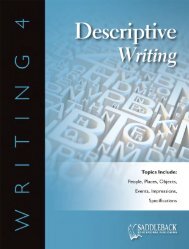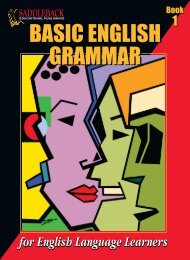Download Sample - SADDLEBACK Educational Publishing
Download Sample - SADDLEBACK Educational Publishing
Download Sample - SADDLEBACK Educational Publishing
Create successful ePaper yourself
Turn your PDF publications into a flip-book with our unique Google optimized e-Paper software.
CONTENTS<br />
▼ Introduction ....................... 4<br />
UNIT 1 Preview .............................. 5<br />
LESSON<br />
1 Glossary .................................... 6<br />
2 Art That Tricks<br />
the Eye ...................................... 9<br />
3 Ludwig Van Beethoven:<br />
The Moody Genius ................. 12<br />
4 Edgar Allan Poe and<br />
“The Raven” ............................ 15<br />
5 What Is a “Masterpiece”? ....... 18<br />
6 Shakespeare’s Theater ........... 21<br />
7 Music in the News:<br />
The Rock and Roll<br />
Hall of Fame, 2001 ................. 24<br />
▼ Unit 1 Review ......................... 27<br />
UNIT 2 Preview ............................ 30<br />
LESSON<br />
1 Glossary .................................. 31<br />
2 Greek Mythology:<br />
Pandora’s Box ......................... 34<br />
3 Woody Guthrie:<br />
Songs of America .................... 37<br />
4 Pen Names .............................. 40<br />
5 Colossal Creations .................. 43<br />
6 Mona Lisa ............................... 46<br />
7 Young Artists in<br />
the News ................................. 49<br />
3 Georgia O’Keeffe:<br />
A New View ............................ 62<br />
4 Introducing Pablo Picasso ...... 65<br />
5 Traditions in Music:<br />
The Work Song ....................... 68<br />
6 Dickens Brings<br />
Characters to Life .................. 71<br />
7 In the News:<br />
Action-Packed Art .................. 74<br />
▼ Unit 3 Review ......................... 77<br />
UNIT 4 Preview ............................ 80<br />
LESSON<br />
1 Glossary .................................. 81<br />
2 The First Haiku ...................... 84<br />
3 The Artist’s Sketchbook ......... 87<br />
4 Verdi’s Aida ............................ 90<br />
5 The Art Museum: Workers<br />
Behind the Scenes .................. 93<br />
6 A Question-Mark Story.......... 96<br />
7 In the News: Children’s<br />
Art World Loses Two of<br />
Its Greats ................................ 99<br />
▼ Unit 4 Review ....................... 102<br />
▼ End-of-Book Test .................. 105<br />
▼ Word List ............................... 109<br />
▼ Teacher’s Notes and<br />
Answer Key ........................... 113<br />
▼ Unit 2 Review ......................... 52<br />
UNIT 3 Preview ............................ 55<br />
LESSON<br />
1 Glossary .................................. 56<br />
2 The Orchestra ......................... 59<br />
3
MUSIC, ART, AND LITERATURE WORDS<br />
UNIT 1<br />
PREVIEW<br />
Here’s an introduction to some of the vocabulary terms, skills, and concepts you will study<br />
in this unit. Answers are upside down on the bottom of the page.<br />
TRUE OR FALSE?<br />
Write T or F to show whether each statement is true or false.<br />
1. _____ The words famous and unknown are antonyms.<br />
2. _____ The word inductee contains the prefix -ee.<br />
3. _____ The prefix re- means “again.”<br />
4. _____ The Greek root phone means “sound.”<br />
5. _____ Lifetime and artist are both compound words.<br />
6. _____ Musical is the adjective form of the noun music.<br />
7. _____ Narrator and author are synonyms.<br />
8. _____ A playwright is a specific type of author.<br />
SPELLING<br />
Circle the correctly spelled word in each group.<br />
1. playwrite playwright playright<br />
2. musishun musicain musician<br />
3. skulptur sculpture sculphure<br />
4. theatere theatar theater<br />
5. artust artist ardist<br />
6. poem poum pome<br />
Answers: true or false? 1. T 2. F 3. T 4. T 5. F 6. T 7. F 8. T<br />
spelling: 1. playwright 2. musician 3. sculpture 4. theater 5. artist 6. poem<br />
© Saddleback <strong>Educational</strong> <strong>Publishing</strong> • www.sdlback.com<br />
5
UNIT 1<br />
Lesson 1<br />
MUSIC, ART, AND LITERATURE WORDS<br />
GLOSSARY<br />
A glossary is an alphabetical list of unusual or specialized words from a certain field<br />
of knowledge. Following are some important words from the fields of art, literature,<br />
and music.<br />
alliteration the repetition of the same<br />
first sound in a group of words<br />
artist a person who creates works<br />
of art such as drawings, paintings,<br />
sculpture, architecture, music, literature,<br />
drama, and dance<br />
audience people gathered to see and<br />
hear something, especially a play,<br />
lecture, or concert<br />
author a person who writes something,<br />
such as a book or story<br />
composer a person who puts notes<br />
together to create a piece of music<br />
design an arrangement of lines,<br />
shapes, patterns, and colors<br />
musician a person trained or skilled in<br />
music, especially one who plays an<br />
instrument<br />
narrator the person in a story who<br />
tells what happened<br />
orchestra a large group of musicians<br />
playing together<br />
photograph a picture made with a<br />
camera<br />
pianist one who plays the piano<br />
playwright a person who writes plays;<br />
also called a dramatist<br />
poem a piece of writing having rhythm<br />
and, often, rhyme; usually in a style<br />
of language that has more feeling<br />
and description than usual writing<br />
or speech<br />
rhyme words that have the same end<br />
sounds, such as cat and hat<br />
scenery the background structures used<br />
to decorate a stage during a play<br />
symphony a long piece of music written<br />
for an orchestra<br />
theater a place where plays are performed<br />
or movies are shown<br />
VOCABULARY IN CONTEXT<br />
Complete each sentence with a word from the glossary. Use the first letter as a clue. Other<br />
words in the sentence will help you decide which word to add. If you’re still not sure,<br />
check the dictionary definition.<br />
1. In Shakespeare’s day, nobles and commoners alike loved going to<br />
the t__________________ to watch plays performed.<br />
6 © Saddleback <strong>Educational</strong> <strong>Publishing</strong> • www.sdlback.com
2. Shakespeare was the English p__________________ who wrote Romeo<br />
and Juliet and Hamlet.<br />
3. The o__________________ played a s__________________ written by the<br />
famous c__________________, Ludwig von Beethoven.<br />
4. In a p__________________ the last words of every other line often<br />
r__________________.<br />
5. The a__________________ painted a picture of the beautiful garden.<br />
6. The painting looked nearly as real as a p__________________ taken<br />
with a camera.<br />
7. The a__________________ rose from their seats at the end of the play.<br />
HIDDEN WORDS PUZZLE<br />
Find and circle the words in the puzzle. The hidden words may go up, down, across,<br />
backward, or diagonally. Check off each word as you find it.<br />
___ alliteration<br />
___ poem<br />
___ photograph<br />
___ orchestra<br />
___ symphony<br />
___ composer<br />
___ musician<br />
___ playwright<br />
___ audience<br />
___ author<br />
___ pianist<br />
___ rhyme<br />
___ artist<br />
___ design<br />
___ scenery<br />
___ theater<br />
A R T I S T P I A N I S T<br />
L U Z A C A P C R P O D V<br />
L R D J A L L O T U P M E<br />
I H R I R Y C M S V H K R<br />
T Y G E E Z U P E I O O S<br />
E M E O P N M O H C T M Y<br />
R E H A N R C S C A O U M<br />
A U T H O R G E R A G S P<br />
T Q U I M T T R O N R I H<br />
I C H T H E A T E R A C O<br />
O E S C E N E R Y M P I N<br />
N G I S E D I L Y V H A Y<br />
N P L A Y W R I G H T N B<br />
___ narrator<br />
© Saddleback <strong>Educational</strong> <strong>Publishing</strong> • www.sdlback.com<br />
7
WORD ROOTS<br />
The Greek root phone means “sound.” The word telephone, for example, means “a device<br />
for sending and receiving sounds.” Read the list of words containing phone. Then write a<br />
letter to match each word with its meaning. Use a dictionary if you need help.<br />
1. _____ symphony<br />
2. _____ saxophone<br />
3. _____ phonetics<br />
4. _____ phonograph<br />
5. _____ xylophone<br />
a. the study of speech sounds as<br />
they are represented in writing<br />
b. device for playing records<br />
c. wind instrument with a curved<br />
metal body<br />
d. long piece of music written for<br />
an orchestra<br />
e. musical instrument with wooden<br />
or metal bars which, when struck<br />
by a hammer, produce tones<br />
CHANGING WORD FORMS<br />
Add vowels (a, e, i, o, u) to complete a different form of a word from the glossary. Use<br />
context clues for help. The first one has been done for you.<br />
1. Beethoven liked to be alone when he c__mp__s__d music.<br />
2. An __rt__st__c person uses his or her talents to create beauty.<br />
3. An interior d__s__gn__r helps people decorate the inside of their<br />
homes and other buildings.<br />
4. The first sc__n__ of the play took place in a schoolyard.<br />
5. Beethoven began playing the p__ __n__ when he was a child.<br />
6. “Smile for the camera,” said the ph__t__gr__ph__r.<br />
7. The sweet tones of the slow, beautiful m__s__c created a<br />
romantic mood.<br />
8. A wounded soldier n__rr__t__d the exciting war story.<br />
o<br />
o<br />
e<br />
8 © Saddleback <strong>Educational</strong> <strong>Publishing</strong> • www.sdlback.com
MUSIC, ART, AND LITERATURE WORDS<br />
UNIT 1<br />
Lesson 2<br />
Art That Tricks the Eye<br />
Have you ever wondered whether<br />
a picture was a drawing or a<br />
photograph? Some artists deliberately<br />
try to trick the viewer. They try to<br />
make a work of art look like the<br />
real thing! This style of art is called<br />
trompe l’oeil. The name, pronounced<br />
trawmp-LOY, is French. It means “to<br />
trick or fool the eye.”<br />
Artists have used different<br />
techniques to create trompe l’oeil.<br />
S o m e h a v e s c u l p t e d r e a l i s t i c<br />
statues of human beings. Others<br />
have modeled wax fruits that<br />
tempt people to take a bite. Interior<br />
decorators have painted windows<br />
on walls and carpets on floors. An<br />
early example of trompe l’oeil was<br />
found in an ancient Roman ruin.<br />
The floor was covered with mosaic<br />
tiles. The image created on the tiles<br />
WAX<br />
WAX<br />
appears to be the remains of a great<br />
feast. The artist even created a mouse<br />
in one corner to nibble the crumbs!<br />
This famous mosaic is known as The<br />
Unswept Floor.<br />
If you keep your eyes open,<br />
you’re likely to see examples of<br />
trompe l’oeil. This is a popular,<br />
entertaining art form. Trompe<br />
l’oeil artists—sometimes called<br />
illusionists—enjoy the challenge<br />
of deceiving their viewers. They<br />
create an optical illusion—an effect<br />
so convincing that viewers truly can’t<br />
believe their own eyes!<br />
WORD SEARCH<br />
1. What eight-letter verb in the reading means<br />
“to have made by shaping clay, wax, or other<br />
materials into statues, figures, or objects”?<br />
2. What six-letter noun means “a picture or<br />
design made by putting together bits of<br />
colored stone, tile, or glass”?<br />
s____________________<br />
m____________________<br />
© Saddleback <strong>Educational</strong> <strong>Publishing</strong> • www.sdlback.com<br />
9
3. What seven-letter adjective means “visual;<br />
having to do with the sense of sight”?<br />
4. What eight-letter noun means “an appearance<br />
that makes viewers perceive something in a<br />
false or mistaken way”?<br />
o____________________<br />
i____________________<br />
SUFFIXES<br />
• Rewrite each boldface word from the reading by adding the correct suffix from the box.<br />
-ist = a person who “does” or “is skilled at” something<br />
-al = “of” or “like” something<br />
1. A trompe l’oeil art ____________________ tries to trick viewers.<br />
2. An illusion ____________________ is a person who tries to make<br />
people think they see what is not really true.<br />
3. An optic ____________________ illusion is a trick of the eye.<br />
• Now write one more word that contains each suffix.<br />
-ist: _________________________<br />
-al: _________________________<br />
ANALOGIES<br />
Analogies are statements of relationship. To come up with the missing word, you must<br />
figure out the relationship between the first two words. Complete the analogies below<br />
with words from the box.<br />
ancient deceiving photograph sculpted tempt<br />
1. Paintbrush is to painting as camera is to _________________________.<br />
2. Want is to desire as lure is to _________________________.<br />
3. Drew is to sketched as modeled is to _________________________.<br />
4. Big is to small as modern is to _________________________.<br />
t<br />
a<br />
5. Working is to laboring as tricking is to _________________________.<br />
s<br />
d<br />
p<br />
10 © Saddleback <strong>Educational</strong> <strong>Publishing</strong> • www.sdlback.com
SYNONYMS<br />
Complete the puzzle with<br />
words from the reading. Clue<br />
words are synonyms (words<br />
with similar meanings) of<br />
the answer words.<br />
ACROSS<br />
1. favorite<br />
3. method<br />
5. found<br />
7. flawless<br />
DOWN<br />
1. snapshot<br />
2. tricking<br />
4. banquet<br />
6. true<br />
1<br />
P<br />
3<br />
T<br />
7<br />
P<br />
5<br />
D<br />
6<br />
R<br />
2<br />
D<br />
4<br />
F<br />
PARTS OF SPEECH<br />
Many words become different parts of speech when they’re used in different contexts.<br />
• The boldface word in each sentence below is used as a noun. Write new sentences<br />
using the words as verbs.<br />
1. An early example of trompe l’oeil was discovered in an ancient<br />
Roman ruin.<br />
________________________________________________________________<br />
2. It appears to be the remains of a great feast.<br />
________________________________________________________________<br />
3. Trompe l’oeil artists—sometimes called illusionists—continue to<br />
take on the challenge of deceiving their viewers.<br />
________________________________________________________________<br />
4. The floor was covered with a design made of mosaic tiles.<br />
________________________________________________________________<br />
• The boldface word in the next sentence is used as a verb. Write a new sentence<br />
using the word as a noun.<br />
5. It means “to trick or fool the eye.”<br />
________________________________________________________________<br />
© Saddleback <strong>Educational</strong> <strong>Publishing</strong> • www.sdlback.com<br />
11
UNIT 1<br />
Lesson 3<br />
MUSIC, ART, AND LITERATURE WORDS<br />
Ludwig Van Beethoven: The Moody Genius<br />
In 1774, four-year-old Ludwig van<br />
Beethoven had to stand on the piano<br />
bench to reach the keys. Eventually, he<br />
became known as Germany’s greatest<br />
pianist. Beethoven’s talent attracted<br />
many friends. But he was a moody<br />
genius. If people talked while he played,<br />
he would walk off in a huff. He was<br />
notorious for rude behavior. Once he<br />
got mad at a waiter and dumped gravy<br />
on the man’s head! The fashionable<br />
hairstyle of the times was neat pigtails,<br />
but Beethoven wore his hair long and<br />
wild. He cared nothing about stylish<br />
clothes.<br />
Beethoven scorned company. He<br />
preferred being alone to compose<br />
symphonies. Sometimes he worked<br />
for days without sleep. Beethoven’s<br />
most well-known notes begin his<br />
Fifth Symphony. They are three short<br />
beats followed by one long beat. Some<br />
people think these notes represent Fate<br />
knocking at the door.<br />
Symphony No. 5 in C Minor<br />
What is the worst thing you could<br />
imagine happening to a musician? In<br />
his twenties, Beethoven began to lose<br />
his hearing. He broke piano strings<br />
by pounding hard enough to hear the<br />
notes. The deaf composer became even<br />
more eccentric. When conducting an<br />
orchestra, he’d shout without realizing<br />
it. In his last performance, Beethoven<br />
could not hear the audience. When<br />
someone turned him around to make<br />
him aware of the applause, Beethoven<br />
began to cry.<br />
The great composer died at age<br />
57. Until the very end, he was a wild,<br />
defiant genius. According to legend,<br />
when a thunderstorm rattled the room,<br />
Beethoven roused himself from his death<br />
bed and shook his fist at the sky.<br />
WORD SEARCH<br />
1. What eight-letter noun from the reading means<br />
“a long piece of music played by a full orchestra”? ___________________<br />
2. What four-letter noun from the reading rhymes<br />
with puff and means “a fit of anger”?<br />
3. What four-letter adjective from the reading<br />
means “incapable of hearing”?<br />
s<br />
h<br />
___________________<br />
d<br />
___________________<br />
12 © Saddleback <strong>Educational</strong> <strong>Publishing</strong> • www.sdlback.com
ANTONYMS<br />
Use the clue words to help you solve<br />
the crossword puzzle. Clue words are<br />
antonyms (words with opposite meanings)<br />
of words in the reading.<br />
1<br />
F<br />
3<br />
S<br />
2<br />
G<br />
ACROSS<br />
4. unknown<br />
5. agreeable<br />
6. never<br />
4<br />
N<br />
DOWN<br />
1. outdated<br />
5<br />
D<br />
2. idiot<br />
3. welcomed<br />
6<br />
E<br />
SYNONYMS<br />
• Write synonyms by unscrambling the letters to spell a word from the box.<br />
conducting eccentric fate roused<br />
1. leading = _____________ (TCUDGICONN) 3. destiny = ______________ (TAEF)<br />
2. odd = __________________ (CENTRECIC) 4. stirred = ____________ (SURDOE)<br />
• Now complete each sentence with one of the unscrambled words. Boldface cue words<br />
are synonyms of the correct words.<br />
5. When Beethoven was (leading) ____________________ an orchestra,<br />
he would wave his arms wildly.<br />
6. In a cruel twist of (destiny) ____________________, the great<br />
Beethoven became deaf.<br />
7. Beethoven’s habits of dress were very (odd) ____________________.<br />
8. Beethoven’s music (stirred) ____________________ great excitement<br />
and emotion in audiences.<br />
© Saddleback <strong>Educational</strong> <strong>Publishing</strong> • www.sdlback.com<br />
13
MULTIPLE-MEANING WORDS<br />
Some words have entirely different meanings when they’re used in different contexts. Find<br />
a word in the reading that matches each pair of definitions below. Write the words on the<br />
lines. Then circle the letter of the definition used in the reading.<br />
1. ____________________ a. a fit of anger (noun)<br />
b. to blow or puff air (verb)<br />
2. ____________________ a. to form by combining (verb)<br />
b. to create or to write (verb)<br />
3. ____________________ a. hits or strikes (verb)<br />
b. units of rhythm in music (noun)<br />
4. ____________________ a. metal devices used to open locks (noun)<br />
b. flat slats that are pressed down to play<br />
certain instruments (noun)<br />
5. ____________________ a. musical tones (noun)<br />
b. written reminders (noun)<br />
6. ____________________ a. a story retold through the years (noun)<br />
b. a description of the details on a map (noun)<br />
ANALOGIES<br />
Analogies are statements of relationship. To come up with the missing word, you must<br />
figure out the relationship between the first two words. Complete the analogies below<br />
with words from the reading. The first one has been done for you.<br />
composer<br />
c<br />
p<br />
1. Artist is to painting as _________________________ is to symphony.<br />
2. Live is to die as laugh is to _________________________.<br />
3. Strings are to violin as keys are to _________________________.<br />
d<br />
c<br />
4. Blindness is to sight as _________________________ is to hearing.<br />
5. Coaching is to team as _________________________ is to orchestra.<br />
14 © Saddleback <strong>Educational</strong> <strong>Publishing</strong> • www.sdlback.com

















